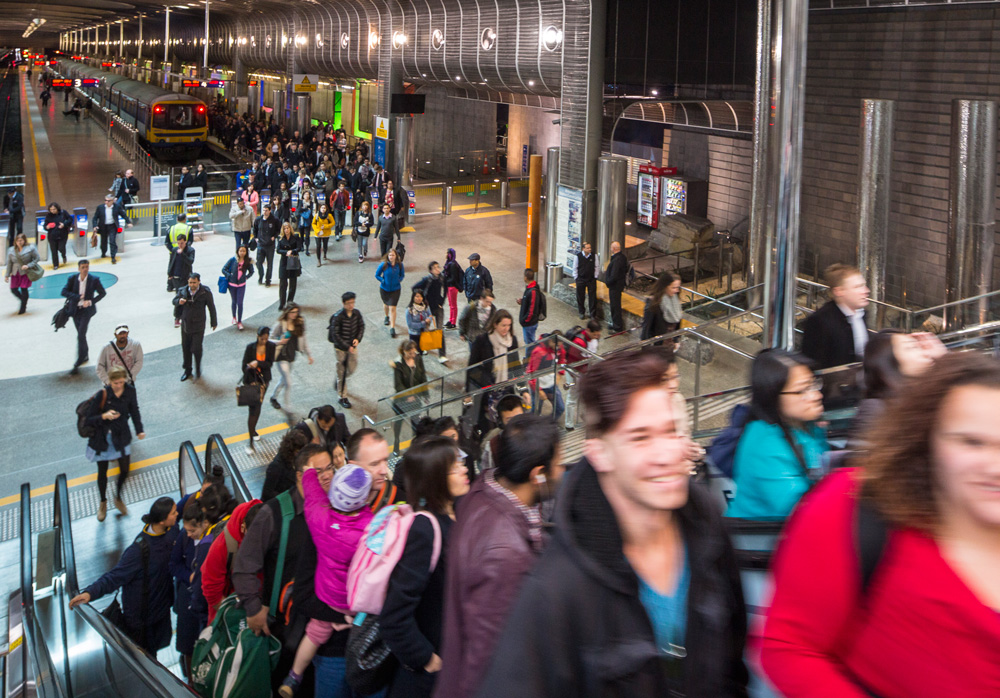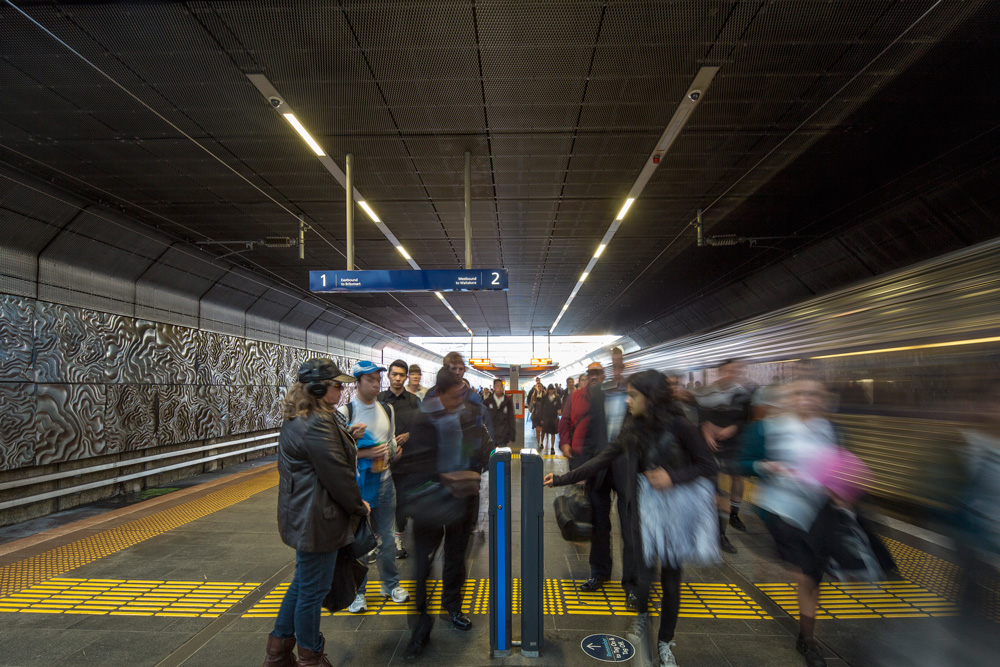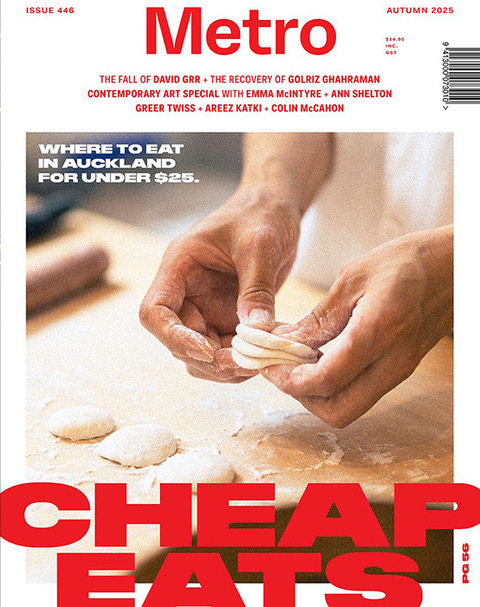Dec 3, 2014 Urban design
There’s an unseen revolution taking place in Auckland right now — in, of all things, transport.
Originally published in Metro, December 2014. Photos by Patrick Reynolds.
Auckland is at last a city. No longer just an overblown provincial town, it has become properly city-shaped, in its scale and in the nature of its problems and its possibilities. For some, this is an unwanted prospect and for others, a much-longed-for one, but either way it’s happening as it usually does: naturally and unevenly, and in our case quite fast. Auckland the teenager now finds itself becoming an adult.
When did we cross this line? We may decide the moment coincided with the reorganisation of local government, the formation of the so-called Super City in 2010. Or not. It doesn’t really matter; the point is that our combination of size and intensity means Auckland is now subject to the logic of cities the world over: crazy prices for tiny spaces, gridlock on the streets at almost any time, hardship right next to luxury.
There is also a new and thrilling diversity: of people, of activity, of possibility. City intensity means all manner of niche businesses become viable — just look at the range of food we’re now offered: not just the ethnicities, but also paleo, raw, vegan, hipster…
While an insane range of complicated and hitherto unimagined ways to brew coffee is not the sole point of city life, it may be a good proxy for its vitality. The cafe trade thrives on diversity, specialisation and excellence, all driven by competition, and those things are also observable through a much wider range of human endeavour. Whether it’s in the law, education, services, the arts, whatever: only the agglomeration of individuals in tight proximity to the economic and social force that is a city can generate such opportunities.
And, of course, there is urban velocity. Everything, for better or worse, is subject to the city’s law of impatience. It has always been thus: just as density creates obstacles to movement, so the demand for movement increases. Perhaps this is the greatest of all the contradictions of a city: more is more but also less. This is also the source of much opposition to the very idea of the city.
Nowhere do these contradictions gather more intensely than around the hotly disputed issue of congestion on the roads: traffic.
No city in the world has road-built its way out of congestion, and why would we want to try?
For the past 60 years, we have only attempted to address this problem from one direction — the supply side: we just built more roads. And we’ve got really good at it; too good, perhaps, given it’s like an addiction for some parts of the system. But clearly we can’t make an infinity of new tarmac; there’s not the space or the money. No city in the world has road-built its way out of congestion, and why would we want to try? Equally, no city is considered glorious because of the extent of its motorways.
The Waterview connection is the last piece of the urban motorway jigsaw. Auckland is now in the next phase of city building. Spending on more and bigger roads now won’t cure Auckland’s traffic congestion, but add to it.
Now is the time to address the demand side: traffic congestion is simply too many people all trying to drive at once. Successful cities offer people more options to get around, enabling more people to rationally choose other movement modes; for more journeys, more often. No city completely “solves” congestion, except failing ones, but the best cities provide people with more good options to avoid taking part in congestion at all.
In this, Auckland is like cities everywhere else in the world, yet is different from both the rest of the country and its own past, which is why this simple fact may seem radical to some.
The way now to both improve our connectivity and de-clog our streets is to invest away from them. We are now in a post-road-building phase.
Perhaps what’s most striking is how well this is already working.
Aucklanders took 12 million trips on the rail network last year. That’s two million more than the previous year: a big jump, and profoundly good news.
Good news for the experts who examined our public transport system and said, frankly, it’s crap, but if you give people attractive and frequent services they’ll choose to use them. Good news for the public, who have long pleaded for better services.
Good news also for the tax- and ratepayers of Auckland, who have funded the upgrades, as well as for the politicians, local and central, who backed them.
Most of all, it is good for drivers. Good for everyone who likes or needs to drive on Auckland’s roads, especially for truckies and tradies, who have no other option. And while Aucklanders are rushing to ride the trains, we are also piling onto buses at new rates too. Overwhelmingly, all these new trips on public transport (PT) are happening instead of car journeys.
It isn’t just new Aucklanders who are taking part in this rush to PT. The city’s population is growing at 2.3 per cent a year, while over the past year, PT use was up 7.6 per cent: that’s more than three times the rate of population growth. Rail use jumped 18 per cent.
In contrast, according to figures from the New Zealand Transport Agency (NZTA), driving in Auckland is flat on a per capita basis, and still below the 2006 peak.
So even if you don’t use the new services yourself, those people who do are out of their cars and out of your way. It may not feel like the streets are any clearer, but if all those travellers were still driving, your trip would be much, much worse.
The biggest winners of Auckland’s new-found and hard-fought transit renaissance, therefore, are the users of cars and trucks.

Over the past decade, multiple billions of dollars have been spent on new and wider roads in Auckland, yet the driving figures show that this spending has been met with a great big shrug. The public are just not rushing out and taking advantage of this new amenity.
Yet conversely, every time we improve our public transport systems, the response is huge. Improvements to the rapid transit network in particular (that’s rail plus the Northern Busway) have led to great uptakes in patronage.
No one is suggesting that driving won’t remain the dominant means to get around Auckland. But it is clear the highest value to be gained now in transport investment is in the complementary modes: trains and buses, ferries, and safe routes for cycling and walking.
To fix gridlock on the roads, we need to stop spending on roads and put that money into the alternatives.
Note that the current population growth rate is exactly 2.3 per cent. Driving growth is dead flat, but everything else is straining at the leash.
Nowhere is this more true than on the rail network and our only properly “rapid” bus route, the North Shore’s Northern Busway.
When cities start to offer fast, frequent, reliable and comfortable services, from modern stations, running late into the night and on weekends, people flock to use them.
The upgrade of the rail network that was begun under the previous government and continued under the current one is being met with open-armed enthusiasm: last month, the two lines that are now running the new trains added 32 per cent and 50 per cent more passengers. And the upgrade is still far from complete.
The popularity of rail when a languishing service is electrified and modernised is known internationally as the “sparks effect”. There’s no mystery to it. Here, as in cities all over the world, when they start to offer fast, frequent, reliable and comfortable services, from modern stations, running late into the night and on weekends, people flock to use them.
This is true rapid transit, and the key to its success is that the service must run on its own right of way. That allows it to be faster, more frequent and more reliable. This is a principal reason the new trains are so desirable, but buses can also be given this advantage — as is the case on the Northern Busway.
The busway is a train-like service with stations, no other stops, high “turn-up-and-go” frequencies and direct, unencumbered routes. It attracts riders well above the rate of other bus services, simply because it is better, and consistently so.
We are not yet delivering services to true rapid-transit standards. As the rail service introduces the new trains to all its commuter lines, we can expect higher frequencies and longer operating hours.
And as the city end of the busway gains more dedicated lanes and proper stations, its services will also improve markedly. Currently, only 41 per cent of its route is separated from other traffic.
All of this makes it baffling that the only thing the government cut from the NZTA’s plans to widen the Northern Motorway in its recently announced special accelerated funding (not from fuel taxes) was the proposed extension of the busway further north. Similarly, the proposed North Western Busway has been excluded from all the work currently being done on the Northwestern Motorway.
This is especially concerning as the buses on the busway run at full cost recovery, or very close to it: fares cover their operation. Which is only possible because buses on the busway are twice as efficient as buses in the rest of the city. For the same cost, a busway bus covers twice the distance of other buses because they are not stuck in traffic — we are not subsidising them to pump out diesel fumes pointlessly as they battle through clogged streets.
A similar logic is at play on the rail network. The new trains glide silently along on our own clean, largely renewably generated electricity, and those electrons cost less than half the price of the dirty old carcinogenic and imported diesel. The new electric trains have more than twice the capacity of the existing trains and, as we’ve seen already, they attract many more fare-paying customers.
Auckland Transport needs to patiently but forcefully explain to drivers that bus and bike lanes are their best friends.
Those two million new passengers this year, each paying anything from $1.60 to more than $10 a ride, are adding upwards of $5 million for services we were running anyway, with more to come: just one more reason the new trains are as pretty to a cost accountant as they are to anyone concerned about the planet.
For the price of building rapid transit systems we get material improvement to both fare income and cost of operation, as well as relief for road users and “place quality” improvement.
It’s worth noting, also, that only a very small part of the whole current system even aspires to rapid-transit status. There is no rapid transit in the northwest, the southeast or around Mangere and the airport. But the potential exists.
While the city works its way around to embracing that potential, there is much else that can be done. Many other bus priority measures can deliver service upgrades and significant operating savings.
Auckland Transport needs to, for example, reduce the amount of street parking on arterial bus routes. This would enable the creation of fully joined-up bus lanes on major bus routes like Mt Eden Rd and Manukau Rd, and could easily be done for at least the peak and shoulder hours.
The major cost here lies in having to endure the complaints of relatively small numbers of people used to parking on these public roads, and of car drivers who fail to grasp that the more fully laden the buses are, the easier their drive will be.
As international evidence shows, the higher the priority given to other modes (including cycling and walking), the better the traffic will flow. This happens because as the other modes improve, more people choose them out of rational self-interest, leaving their cars at home more often.
Auckland Transport needs to patiently but forcefully explain to drivers that bus and bike lanes are their best friends, emptying their lane of other vehicles, saving them in rates and taxes and increasing the productivity of the whole city. It is not clear the culture at AT is ready for such sophistication.
Over the next year and a half, the two big lines, the Southern and the Western, will get their new trains and higher frequencies. More rail ridership growth is already baked into the pie — but even on the rail network there are looming problems.
One issue is the boom in rail freight going on right now, especially into and out of Auckland and Tauranga. This is great news: it’s far better to be moving those heavy loads on trains and not on dangerous, less-fuel-efficient, road-damaging trucks.
But it also means the rail lines at the core of the Auckland network are getting a great deal of new traffic carrying both passengers and freight. The long-planned third track on the main trunk route through the industrial areas of South Auckland is desperately needed to alleviate this pressure. It won’t be a huge expense — certainly, it will cost a great deal less than the $140 million to be showered on one intersection on the way to the airport next year — but because it’s rail, it gets no love from the government.

Which brings us to the City Rail Link. Without the CRL, all growth on the network has an absolute upper limit. Continuing as we are, last year’s number will double in just four years to 20 million by 2017.
And there it will stall. The dead end at Britomart means it just won’t be possible to run enough trains to meet demand. As it is, Auckland Transport predicts the Britomart limit to hit in 2016.
The CRL, however, will turn Britomart from an in-and-out station into a genuine metro-style through station. New direct services will more than double the frequency and efficiency of our new trains, which will attract even more users. The potential for this to transform not just our travel behaviour but much else in the city is enormous.
The possibilities the CRL will unlock have not been well presented. It seems easier to discuss what it costs than what it’s worth.
And if the CRL is delayed to the mid-2020s? We’ll be wasting half the capacity of the existing rail network, and holding back the city’s potential. Auckland will be stuck with its inefficient over-reliance on car travel; we will lack the balance of a city with great options for its citizens; we will have less freedom of choice.
It is hard not to be deeply critical of the way Auckland Council and Auckland Transport have communicated the value of this project. Even though surveys repeatedly show the public is way ahead of the government and its officials in understanding the need to invest in urban rail, the possibilities the project will unlock have not been well presented. It seems easier to discuss what it costs than what it’s worth.
Perhaps that’s because the outcomes are so multifaceted and game-changing. Perhaps it’s also that those responsible for promoting the CRL struggle themselves to imagine how different the city will be once it’s here.
The new Aotea Station, at the heart of the densest centre of employment and learning in the entire nation, will immediately be busier than Britomart. But still that’s not the most powerful effect of this project; its real genius lies in the way it joins up the disparate ends of the existing network and thereby transforms it from a commuter, timetable-dependent, in-and-out system to a high-frequency, turn-up-and-go, through-routed, metro-style network.
And there will be no assumption that your destination is always in the inner city: you will be able to make any number of intermediate, cross-town, and less-predictable journeys.
One way to think of the CRL is to compare it to the motorway junction it will pass under. Imagine driving into town on a motorway, and having to stop short because there is no Spaghetti Junction to join everything up. That’s how it is for public transport users in Auckland now. The CRL is the key that will unlock the whole urban rail network, just as Spaghetti Junction has for motorway users.
And despite being just two little tunnels seamlessly snaking their way beneath our streets, it will be more like the motorway network in capacity than you might expect. The CRL will enable up to 24 trains each way per hour, each carrying up to 750 people.
That’s like adding a new eight-lane motorway that simultaneously comes from three directions into and through the city, without putting a single extra vehicle on the streets.
This is the spatial efficiency of urban rail. It delivers an enormous economic force: people, without each one of them coming with a space-eating tin box.
We now have around 90km of nearly fully upgraded electrified rail line. Some 40 stations of varying quality. Yet the potential of this high-capacity resource is underutilised and largely hidden from most Aucklanders.
Doubling patronage to 20 million trips a year is not enough. Rail will remain a bottled-up force until it climbs to 30, 40, 50 million trips, which is what the CRL will deliver.
This is the great opportunity of the CRL, and there is no other city in the world in Auckland’s position. Most would leap at the chance to get a widespread metro system just for the cost of 3.4km of tunnels and three new stations. This is the greatest deal we will see for generations.
That’s how the CRL should be being marketed. Not as an inner-city project but as the means to deliver clean, efficient, reliable rapid transit — a true metro system — across most of the city. And improving the utility of the rest of the PT network — especially for Northern Busway users, the other part of the Rapid Transit network — by improving onward connections and also by replacing buses in the city, making room for more from the Shore.
The City Rail Link will pick up every station on the Western Line and shift them closer to the inner city. If you live in Glen Eden, you will be as close to midtown as Kingsland is now.
The post-CRL network will improve our options in so many ways. Get to that show at Vector Arena or the rugby at Eden Park; shop at Sylvia Park, attend the Manukau Institute of Technology… all at speed and no hassles trying to find or pay for a carpark. And all with the freedom to move on, instantly and in more directions, on a whim.
This is especially so for those on the Western Line because it will give those trains a direct route into and through the city instead of trundling them on a roundabout journey south via Newmarket.
This will lead to some startling time savings. Travellers from New Lynn, for example, catching a train to town and then a bus up to the site of the new Aotea station at midtown will cut their journey from 51 minutes to 23.
The CRL will in effect pick up every station on the Western Line from Mt Eden out and shift them substantially closer to the inner city. And proximity equals value. If you live in Glen Eden you will be as close to midtown as Kingsland is now. Boom!
The harbour bridge, opened in 1959, was the last Auckland project to achieve this kind of transformation, by moving the North Shore closer to the city. The value of the bridge was just as misunderstood before it was built, hard as that may be to believe now.
The CRL will do for the west what the bridge did for the north. West Auckland needs that, and all of Auckland needs it for them. The west struggles with a lack of local employment and underpowered local business opportunities. With the CRL, Westies will be able to commute more easily to the huge job market of the central city, and that will make Avondale, New Lynn and centres further west more attractive to live in, and therefore more attractive to do business in.
Why stop there? I have an even bolder claim for Auckland, once the CRL is operating, and I’m certain I’m on the money: I believe this new layer to our world will profoundly alter Auckland’s very idea about itself.
The growth of a metro system out of our inefficient little commuter network will redefine the city. The beautiful harbours and extraordinary volcanic cones, and all the cultural strengths of tangata whenua and the waves of immigration that have followed — those are the things we treasure because they make us not like anywhere else. But we’ll also have a thing that’s taken for granted among nearly all really good cities. We’ll have decent rapid transit. We’ll be a metro city.
With our new metro system and the spatial improvements made possible by its seamless capacity, Auckland will genuinely be able to compete with those bigger cities across the Tasman for quality, economic effectiveness and desirability, and it will better them. Without needing to get that big.
The Jewel of the South Pacific.
It’s right there, that possibility. Now.
Are Motorway Tolls the Answer?
Mayor Len Brown’s independent advisory group has proposed a toll for all motorway users, as a way to fund transport costs over the next 30 years. It’s a bad proposal.
True, charging directly to use motorways, especially if varied by time of day, can help manage the “peakiness” of that part of our road network. Many people, confronted with a charge, will either drive at other times, find an alternative form of transport or find another route. But there are several reasons this proposal is badly flawed:
• Vehicles will shift off motorways and onto local roads, which is the very problem motorways are built to deal with in the first place. Ready for the nightmare on East Coast Rd? Great North Rd and Great South Rd?
• In cities like London, Stockholm and Singapore, road pricing works quite well — because those cities have mature public transport options. Auckland doesn’t have that yet.
• Tolls at every motorway entrance involve high set-up and operating costs, especially compared to fuel taxes and road-user charges.
• Tolls will hit poorer people disproportionately hard.
Motorway tolling may be a good fundraiser and a good incentiviser for public transport, cycling and walking, once wider and more efficient rapid transit is in place — including the CRL, a northwest busway and the Auckland-Manukau Eastern Transport Initiative.
The best solution to fix the “funding gap” in transport?
• Stop spending money on mega-motorway projects.
• Roll out rapid transit as fast as possible.





